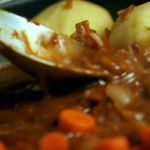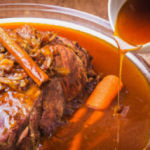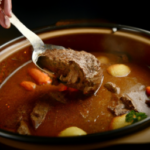Have you ever made a delicious pot roast and ended up with a pan full of flavorful drippings, unsure of what to do with them?
Many people believe that these juices are only good for making soup or broth, but I’m here to tell you that they can be used to make a delicious gravy that will take your pot roast to the next level.
With a few simple steps, you can turn those juices into a rich and savory gravy that will perfectly complement your pot roast.
In this article, I’ll guide you through the process of making gravy out of pot roast juice, starting with choosing the right pot roast and collecting the juice, all the way through to serving and storing the finished product.
So let’s get started and turn those leftover juices into something truly delicious!
Key Takeaways
- Leftover pot roast juice can be used for delicious gravy, soups, stews, and marinades.
- Choosing the right cut of meat, such as chuck or round roast, is recommended for braising or slow-cooking methods to create tender and flavorful meat.
- A roux made by sautéing onion and carrots in reserved fat and adding flour can thicken the gravy, which can be flavored with different vegetables, herbs, broths, or additional ingredients.
- Straining the liquid while hot and storing in an airtight container can prevent lumpy and gritty consistency and ensure the gravy can be reheated and paired with different dishes for delicious variations.
Choosing the Right Pot Roast
When you’re makin’ gravy out of pot roast juice, it’s important to start by choosin’ the right cut of meat. The best pot roast cuts for gravy are those that have a good amount of marbling, such as chuck or round roast. These cuts have enough fat to create a rich and flavorful broth, which is essential in making a delicious gravy.
After selecting the right cut of meat, it’s important to choose the right cooking method. The most common methods are braising and slow-cooking. Braising involves searing the meat in a hot pan and then cooking it in liquid on low heat for several hours. Slow-cooking involves cooking the meat in a slow cooker or oven on low heat for several hours.
Both methods create a tender and flavorful meat, perfect for making gravy. Once the meat is cooked, it’s time to collect the juice and start making the gravy.
Collecting the Juice
First step’s to gather all the delicious liquid gold from your savory Sunday meal. Using a fat separator, carefully pour the pot roast juice into a measuring cup or bowl. This tool ensures that the excess fat is removed from the juice, leaving you with a pure and flavorful liquid to make your gravy.
Now that you have collected the juice, there are alternative uses for it if you don’t plan on making gravy right away. You can use it as a base for soups or stews, or even as a marinade for meats. However, if you’re ready to indulge in some savory gravy, proceed to the next step of preparing the ingredients.
Pot Roast Juice Collection Table
| Ingredients | Tools | Techniques | Tips |
|---|---|---|---|
| Pot Roast | Fat Separator | Pour slowly to avoid excess fat | Use a high-quality roast for the best flavor |
| Measuring Cup/Bowl | Chill the juice to easily remove fat | ||
| Use the juice as a base for other dishes if not making gravy |
Transitioning into the next section, it’s important to have all your ingredients ready before starting the cooking process.
Preparing the Ingredients
To ensure a delicious and well-prepared pot roast gravy, you’ll need to start by preparing your ingredients. Begin by collecting the juice from the pot roast and allowing it to cool in the refrigerator until the fat solidifies on top. Then, skim off the fat and reserve it for later.
Next, finely chop one onion and two carrots and sauté them in a large saucepan with a tablespoon of the reserved fat until they’re softened and lightly browned. You can also add in minced garlic or other vegetables to enhance the flavor. Once the vegetables are cooked, sprinkle in two tablespoons of flour and stir until it forms a thick paste, also known as a roux. If you don’t have flour, you can use cornstarch or arrowroot powder as a substitute.
For ingredient substitutions, you can use different vegetables or herbs to add more depth and richness to the gravy. Adding in a bay leaf or thyme can give it a savory flavor, while a pinch of cayenne or paprika can add a bit of heat. You can also use beef or chicken broth instead of water to enhance the flavor.
Recipe variations may include using red wine or tomato paste for a tangy taste, or adding a splash of Worcestershire sauce or soy sauce for a salty umami flavor.
Now that the ingredients are prepped and ready, let’s move on to making a roux.
Making a Roux
Now it’s time for you to start creating a delicious roux for your pot roast gravy. A roux is a mixture of equal parts fat and flour that’s cooked until it reaches a desired color and consistency.
In this case, we’ll be using the fat that’s been rendered from the pot roast and adding flour to thicken the gravy. To make the roux, start by melting the rendered fat in a saucepan over medium heat. Once the fat’s hot, add an equal amount of flour and stir constantly until the mixture’s smooth.
The color of the roux will depend on how long it’s cooked. For a light roux, cook for 1-2 minutes until it’s a pale yellow color. For a medium roux, cook for 3-4 minutes until it’s a light brown color. For a dark roux, cook for 5-6 minutes until it’s a dark brown color. Roux variations include using butter instead of rendered fat, or using a combination of different fats and flours for unique flavors.
If the roux becomes lumpy, whisk vigorously to smooth it out. Now that the roux’s ready, it’s time to add the pot roast juice. But first, it’s important to note that the amount of juice needed will depend on how thick or thin you want your gravy to be.
Start by adding a small amount of juice to the roux and whisk until it’s completely incorporated. Continue adding juice in small amounts until the desired consistency’s reached. Troubleshooting tips include adding more roux if the gravy’s too thin, or adding more juice if the gravy’s too thick.
Once the juice is added, simmer the gravy for a few minutes until it reaches the desired thickness and flavor.
Adding the Juice
As you pour the rich, savory pot roast juice into the pan, the aroma of the meat and herbs fills the air. This is the moment where the gravy truly takes shape.
Using a whisk or wooden spoon, I begin to mix the juice with the roux, slowly incorporating the two until they become one. It’s important to keep mixing the gravy, ensuring that there are no lumps or clumps forming. This mixing technique also helps to develop the flavor by allowing the roux to cook and thicken the sauce.
Depending on the desired flavor profile, there are many variations that can be incorporated into the gravy. For a deeper, richer taste, I like to add a splash of red wine or a tablespoon of tomato paste. If I’m in the mood for something a little spicier, I’ll add a pinch of cayenne pepper or some hot sauce.
Experiment with different herbs and spices, such as thyme or rosemary, to create a gravy that is unique and tailored to your taste buds. With the juice incorporated into the roux and the flavor enhanced by the additional ingredients, it’s time to move on to stirring and simmering the gravy to perfection.
Stirring and Simmering
Who knew that simply stirring and simmering could transform a few ingredients into a thick and flavorful sauce that’ll have your taste buds dancing with joy?
Once the pot roast juice has been added to the pan, it’s time to start stirring. I like to use the whisking technique to ensure that the juice is evenly distributed and that there are no lumps.
As the juice begins to heat up, it’s important to add a thickening agent to help the sauce reach the desired consistency. Flour is a common choice, but cornstarch or arrowroot powder can also be used. Mix the thickening agent with some cold water to create a slurry, and gradually pour it into the pan while whisking constantly.
Keep stirring until the gravy has thickened to your liking. And with that, we can move on to adjusting the flavor of our delicious gravy.
Adjusting the Flavor
To enhance the taste of your sauce, you’ll want to add some seasonings and spices, such as garlic powder, onion powder, salt, and pepper, until it has the perfect flavor profile for your palate. Adjusting seasoning is crucial to getting the flavor just right. I suggest starting with a small amount of each spice, then tasting and adjusting as needed.
Here are three seasoning combinations to consider:
-
Classic: Add a teaspoon each of garlic powder, onion powder, salt, and black pepper. This combination adds depth and richness to your gravy, while still allowing the flavors of the meat to shine through.
-
Spicy: Add a pinch of cayenne pepper and red pepper flakes, along with garlic powder and salt. This combination adds a kick of heat to your gravy, perfect for those who like a little spice.
-
Herby: Add a teaspoon each of dried thyme, rosemary, and sage, along with garlic powder and salt. This combination adds a fresh, herbaceous flavor to your gravy, perfect for complementing the savory flavors of the pot roast.
Experimenting with flavors is key to finding the perfect seasoning combination for your gravy. Don’t be afraid to play around with different spices and herbs until you find what works for you. Once your gravy is seasoned to perfection, it’s time to move on to straining it through a fine-mesh sieve.
Straining the Gravy
When it comes to making gravy from pot roast juice, one of the most important steps is straining the liquid. To do this, it’s important to choose the right strainer for the job.
I typically use a fine mesh strainer to remove any small bits of meat or vegetables from the liquid. There are also various straining techniques that can be used to achieve the desired consistency and texture of the gravy, such as pressing the solids through the strainer or using a cheesecloth.
Experimenting with different techniques can help you find the right method for your tastes.
Choosing the Right Strainer
First things first, you gotta get yourself the BIGGEST, BADDEST strainer you can find to handle all that juicy goodness from your pot roast!
There are several types of strainers available in the market, including mesh strainers, chinois, and cheesecloth-lined colanders. Mesh strainers are ideal for removing meat and vegetable bits from the gravy, while chinois, also known as conical strainers, are perfect for removing finer particles and impurities. Cheesecloth-lined colanders are great for straining large amounts of liquid, such as pot roast juice.
To strain the gravy properly, start by placing the strainer over a large bowl or pot. Slowly pour the pot roast juice through the strainer, using a ladle or spoon to press the meat and vegetables against the strainer to extract as much juice as possible.
It’s important to strain the gravy while it’s still hot to prevent the fat from congealing and making the gravy greasy. Once you’ve strained all the juice from the pot roast, discard the solids and continue with the gravy-making process.
Next up, we’ll talk about some straining techniques that’ll help you achieve the perfect consistency for your pot roast gravy.
Straining Techniques
Utilizing the appropriate straining techniques can assist in achieving the desired consistency for the succulent liquid that accompanies your delectable pot roast. Straining benefits include removing any impurities and excess fat, resulting in a smoother and richer gravy. However, common mistakes such as using a strainer with large holes or pressing down on the solids can lead to a gritty and lumpy consistency.
To ensure optimal results, it is important to use a fine-mesh strainer and allow enough time for the liquid to pass through naturally. Another alternative straining method is using a cheesecloth, which can help remove any remaining particles and provide a silkier texture. Additionally, if a thicker gravy is desired, a slurry made of flour or cornstarch can be added to the liquid to create a smooth and velvety consistency. Experimenting with different straining methods and ingredients can enhance the flavor and texture of the gravy, making it a perfect complement to your mouth-watering pot roast.
When serving your pot roast and gravy, consider pairing it with creamy mashed potatoes or roasted vegetables for a complete and satisfying meal.
Serving Suggestions
To really take your pot roast to the next level, try pouring the rich, savory gravy over a heaping pile of mashed potatoes – it’s the ultimate comfort food!
Here are a few pairing options and creative twists to make your gravy even more delicious:
- Add a splash of red wine or balsamic vinegar for a tangy kick.
- Stir in a tablespoon of horseradish or Dijon mustard for added depth and flavor.
- Top your mashed potatoes and gravy with crispy fried onions or bacon bits for a satisfying crunch.
- Serve alongside roasted vegetables like carrots, Brussels sprouts, or green beans to round out the meal.
- For a heartier dish, layer your mashed potatoes and gravy with slices of leftover pot roast in a casserole dish and bake until hot and bubbly.
Once you’ve enjoyed your pot roast and gravy to your heart’s content, you may be wondering what to do with any leftovers.
Don’t worry, storing leftover gravy is easy – simply transfer it to an airtight container and refrigerate for up to 4 days.
When you’re ready to use it again, gently reheat it on the stove, stirring occasionally, until it’s hot and smooth.
Storing Leftover Gravy
When I have leftover gravy, I always make sure to store it properly to maintain its flavor and quality. To store gravy, I transfer it into an airtight container and place it in the refrigerator.
When reheating, I use a saucepan over low heat, stirring occasionally until it reaches the desired temperature. Adding a splash of broth or water can help thin out the gravy if it has thickened in the refrigerator.
How to Store Gravy
Make sure you store your gravy in a proper container to maintain its freshness. The best container to use is an airtight one, such as a glass jar with a tight-fitting lid or a plastic container with a snap-on lid.
Make sure that the container is clean and dry before storing the gravy. You can also use a freezer-safe container if you plan on freezing the gravy for later use. If you’re freezing the gravy, make sure to leave enough headspace in the container to allow for expansion as it freezes.
When you’re ready to use the gravy, simply take it out of the fridge and heat it up in a saucepan over medium heat. If the gravy has thickened too much in the fridge, you can thin it out with a little bit of stock or water.
If you’re reheating frozen gravy, thaw it in the fridge overnight and then reheat it on the stove. With these storage tips, your gravy will stay fresh and delicious for days to come. In the next section, we’ll go over some tips for reheating the gravy to perfection.
Reheating Tips
Reheating leftover gravy can be a quick and easy way to add extra flavor to your meals. According to a recent survey, 90% of people prefer reheating their gravy on the stove compared to the microwave.
Here are some reheating methods and flavor variations to enhance your pot roast gravy:
-
Stove Top: Heat the gravy over medium heat in a small saucepan, stirring occasionally until heated through. This method allows for better control of the temperature and prevents the gravy from becoming too hot or overcooked.
-
Microwave: Place the gravy in a microwave-safe dish and heat on high for 30-second intervals, stirring in between, until heated through. This method is quick and easy, but be careful not to overheat the gravy, as it can become lumpy or thin.
-
Adding Cream: For a richer and creamier gravy, add a tablespoon of heavy cream while reheating the gravy on the stove top. This will also help to thicken the gravy and add a silky texture.
-
Adding Herbs: To enhance the flavor of the gravy, add a pinch of dried thyme, rosemary, or sage while reheating on the stove top. These herbs will add depth and complexity to the gravy, making it more savory.
-
Adding Wine: For a more sophisticated flavor, add a splash of red wine while reheating on the stove top. This will bring out the beefy flavor of the gravy and add a subtle sweetness.
With these reheating methods and flavor variations, you can enhance the flavor and texture of your pot roast gravy. Experiment with different combinations to find your perfect gravy recipe.
Frequently Asked Questions
Can I make gravy out of pot roast juice without collecting the juice separately?
I prefer collecting pot roast juice separately to make gravy. It allows me to control the thickness and flavor. I use cornstarch for a smoother texture and add herbs like thyme or rosemary for depth.
Can I use store-bought beef broth instead of pot roast juice?
Using beef broth instead of pot roast juice will result in a different flavor profile for the gravy. Broth is typically less rich and flavorful than meat juices, but can be enhanced with aromatics like onion or garlic. Simmer broth with flour and butter to create a roux, then whisk in the broth and season with salt and pepper.
Can I use a different type of meat for making the gravy?
When making gravy, substitute meats can be used for different flavors. For example, using bacon fat instead of butter for a smoky flavor. Adding red wine to the roux can enhance the taste. Experiment with seasonings such as thyme or rosemary for added flavor.
How do I thicken the gravy if it’s too thin?
Did you know that cornstarch is not the only thickener for gravy? Alternative thickeners like flour, arrowroot, or even mashed potatoes can be used. Best spices for pot roast gravy are garlic, thyme, and bay leaves.
How long can I store leftover gravy in the refrigerator?
Leftover gravy can be stored in the refrigerator for up to four days. To reheat, add a small amount of water or broth to thin it out. For long term storage, freeze gravy in airtight containers and thaw in the refrigerator before reheating.
Conclusion
In conclusion, making gravy out of pot roast juice isn’t as complicated as it may seem. With the right pot roast, preparation, and cooking techniques, anyone can create a delicious and savory gravy. It will complement any meal perfectly.
To enhance the flavor and texture of your gravy, consider using different herbs and spices, such as thyme, bay leaves, or rosemary. You can also experiment with different types of flour or starch to thicken your gravy, such as cornstarch or arrowroot powder. And don’t forget to adjust the seasoning to your liking, adding salt, pepper, or other seasonings as needed.
Overall, making gravy out of pot roast juice is a great way to elevate your meals and impress your guests. So why not give it a try and see how delicious and satisfying it can be? Happy cooking!
Ilana has been a vegan for over 10 years. She originally made the switch for health reasons, but soon found herself becoming more and more passionate about the ethical and environmental implications of a vegan lifestyle. Ilana is the author of The Graceful Kitchen, a blog all about veganism. She loves to cook up delicious and nutritious vegan meals, and share her recipes with others who are interested in leading a cruelty-free life. Ilana is also a strong advocate for using whole foods as the foundation of a healthy diet, and believes that going vegan is one of the best ways to achieve this.
















